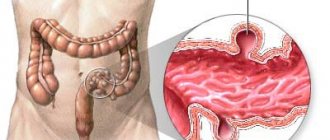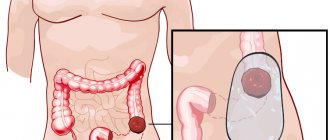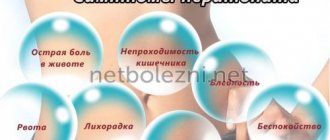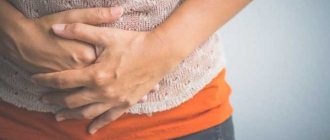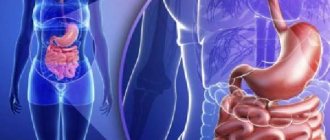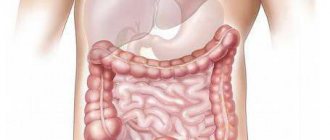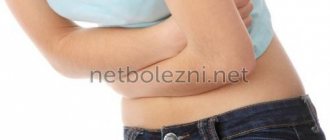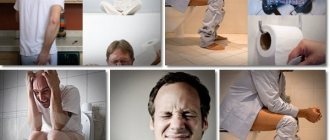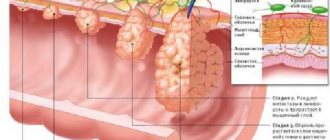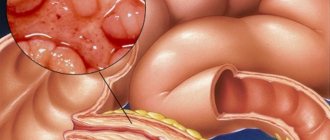Question: Is physical activity prohibited for diverticulosis and diverticulitis?
The site provides reference information for informational purposes only.
Diagnosis and treatment of diseases must be carried out under the supervision of a specialist. All drugs have contraindications. Consultation with a specialist is required! Is it possible to play sports and generally overload the body with diverticulosis and diverticulitis?
For uncomplicated diverticulosis
physical activity is a factor that can lead to inflammation in the abdominal cavity. The fact is that almost any exercise, one way or another, increases intra-abdominal pressure. If there are pathological formations, they can easily be pinched between other organs. This will lead to the beginning of the inflammatory process.
However, the presence of diverticulosis does not mean that the patient should completely give up physical activity. Physical inactivity ( sedentary lifestyle)
) itself impairs the functioning of internal organs, including the intestines.
Regular light physical activity helps the organs cope with their functions. In relation to the intestines, this is reflected in its muscle tone and ability to push food along the gastrointestinal tract ( gastrointestinal tract
).
Thus, for uncomplicated diverticulosis, the following types of physical activity are recommended:
- walking;
- swimming ( not for time or endurance
); - gymnastic exercises for the limbs ( without the active participation of the abdominal muscles
).
You will have to exclude all loads that can significantly increase intra-abdominal pressure, as well as some sports:
- speed running;
- lifting weights ( more than 10 – 15 kg
); - any abdominal exercises;
- jumping;
- football, basketball and other contact sports ( as a result of a fall or collision, you may receive a blow to the stomach, which will provoke inflammation
).
Diverticulitis
, in itself, suggests the presence of an inflammatory process in the abdominal cavity. In the acute course of the disease, the patient experiences pain, and his general condition, as a rule, does not allow any physical activity. Until the inflammatory process is eliminated or diverticulitis becomes chronic, it is recommended to remain in bed.
Otherwise, life-threatening complications may develop, including:
- peritonitis;
- intestinal obstruction;
- internal bleeding.
Diverticulosis of the sigmoid colon is a pathology in which protrusions appear on the surface of this section of the intestine, resembling pockets - diverticula. Today, this disease is the most common in gastroenterology. People of any gender are susceptible to sigma diverticulosis, and the main risk criterion is the patient's age: diverticula are not diagnosed in people under 30 years of age.
Patients turn to a specialist in case of complications, when the first complaints appear; Before this, the pathological process may be asymptomatic.
Often patients with pain in the left half of the abdomen, dyspepsia, unstable stool, after consulting a therapist, ask: “Which doctor treats diverticulosis of the sigmoid colon?” The specialist is called a “gastroenterologist,” but in emergency situations, hospitalization in the abdominal surgery department is possible.
Treatment involves proper nutrition and medication, but there are life-threatening complications that may require surgery. Diverticula in the sigmoid colon have different sizes, but most often they are small, with a diameter of up to 1 cm. Almost a third of the population aged 40-50 years faces intestinal diverticulosis, and only 10% have clinical manifestations.
The intensity of this disease increases in proportion to age. This is due to the following factors:
• loss of elasticity of the intestinal wall; • chronic constipation due to loss of peristalsis and associated increase in intracavitary pressure in the intestine; • tendency to flatulence.
In addition, there is evidence that predisposing factors include heredity, dietary habits and some diseases of the gastrointestinal tract, for example, megadolichosigma, in which overstretched atonic walls contribute to the appearance of protrusions.
The incidence of diverticulosis depends on diet; in regions where preference is given to foods rich in fiber, diverticulosis is less common. Fiber helps optimize the digestive process.
Depending on the severity of the pathological process, therapy is prescribed. In some cases, diverticulosis of the sigmoid colon is complicated by life-threatening conditions:
• intestinal bleeding; • diverticulum perforation; • acute intestinal obstruction; • inflammation of the peritoneum.
These complications require emergency surgery.
Sometimes a localized abscess develops in the diverticulum cavity, which is manifested by pronounced changes in tissue morphology. If the abscess breaks into the intestinal cavity, recovery will occur; if pus escapes into the abdominal cavity, there is a risk of peritonitis. Involvement of nearby organs and tissues in the pathological process can be complicated by the formation of a fistula.
Laxatives
One of the symptoms of intestinal diverticulum is constipation. Boiled beets are used as a natural laxative. Boiled beets are used as a salad with the addition of olive oil. To loosen stools, decoctions of dried fruits are used.
The information” on our website is provided by qualified doctors and is for informational purposes only. Don't self-medicate! Be sure to consult a specialist!
Author: Rumyantsev V. G. Experience 34 years.
Gastroenterologist, professor, doctor of medical sciences. Prescribes diagnostics and carries out treatment. Expert of the group for the study of inflammatory diseases. Author of more than 300 scientific papers.
Diverticulosis of the sigmoid colon is a pathology in which protrusions appear on the surface of this section of the intestine, resembling pockets - diverticula. Today, this disease is the most common in gastroenterology. People of any gender are susceptible to sigma diverticulosis, and the main risk criterion is the patient's age: diverticula are not diagnosed in people under 30 years of age.
Patients turn to a specialist in case of complications, when the first complaints appear; Before this, the pathological process may be asymptomatic.
Often patients with pain in the left half of the abdomen, dyspepsia, unstable stool, after consulting a therapist, ask: “Which doctor treats diverticulosis of the sigmoid colon?” The specialist is called a “gastroenterologist,” but in emergency situations, hospitalization in the abdominal surgery department is possible.
Sigmoid colon
The sigmoid colon gets its name from its curves that resemble the Greek letter “sigma.” This intestine is a section of the large intestine, S-shaped, starting from the descending part of the colon in the upper parts of the small pelvis and goes to the left half of the abdomen, and then passes into the rectum. Its length is more than half a meter, diameter is about 4 cm.
The role of sigma in the digestive process is the absorption of liquid from food gruel. The blood supply and innervation of the sigmoid colon is provided by the mesentery, which consists of a large number of nerve and vascular structures.
Symptoms of diverticulosis of the sigmoid colon
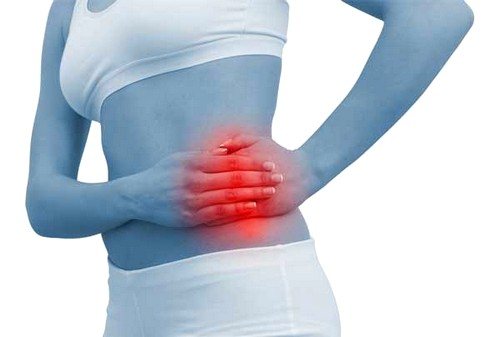
ICD-10 code: K57
In most patients, diverticulosis occurs without significant symptoms and is detected incidentally during diagnostic tests for other diseases.
Some patients occasionally experience slight discomfort in the left iliac region after eating. Sometimes bloating is accompanied by pain; when the gases are released, the pain and flatulence are relieved.
If inflammation of the intestinal walls occurs, the following symptoms appear:
• increased tempera reaction; • intoxication: nausea and vomiting; • dizziness; • increased abdominal pain.
Going to the toilet does not bring relief.
When a diverticulum ruptures, signs consistent with peritonitis are present. The appearance of blood after defecation indicates damage to the vessels of the sigmoid colon. The more blood is lost, the more severe the anemia, and the less strength remains to fight the disease.
Read more Periods last 2 days, this is normal
Diagnostics

Initially, the doctor talks with the patient, clarifies the history of the disease, then proceeds to a physical examination.
When palpating the left iliac region in patients with diverticulosis of the sigmoid colon, pain is noted, but the final diagnosis is established using instrumental and laboratory diagnostic methods. Examination algorithm:
• general blood test (will show the presence of inflammation: increased leukocyte levels and increased erythrocyte sedimentation rate); • blood biochemistry; • general urine analysis; • analysis of stool for occult blood, the nature of digestion. • X-ray examination of the large intestine with radiocontrast enhancement. • colonoscopy.
Depending on the diagnostic results, complaints, age of the patient, concomitant pathology, a treatment regimen is selected.
If the disease does not impair the quality of life and is in an asymptomatic or uncomplicated phase, then it is recommended to pay attention to the following aspects:
1. Optimizing your diet: increased amount of fiber (eat more vegetables and fruits), drink enough liquid so that the stool is soft and does not stretch or injure the intestinal walls. During an exacerbation, you can only take liquid food for 3 days, this helps restore the intestinal mucosa and reduce the inflammatory process.
2. Giving up bad habits.
3. Physical therapy.
In case of complaints and inflammation, conservative therapy is carried out.
Diagnostic methods
During the examination of the patient, the gastroenterologist takes into account several aspects:
- Patient complaints.
- Having bad habits.
- Age.
- Nutritional features.
- Tendency to bowel movements.
By palpation, the presence of disease-specific pain in the abdominal region is determined.

Patient examination
After examining the medical history, the doctor will assume the presence of diverticular disease in the intestines. For the assumption to be confirmed, the patient needs to undergo several laboratory and hardware tests.
Assigned studies:
- Colonoscopy - allows you to assess the condition of the intestines inside.
- Irrigoscopy is taking an X-ray of the intestine, which is filled with a special composition beforehand.
- Laparoscopy – examination and treatment of the intestinal surface through punctures in the abdomen.
Attention! In addition to the methods listed, the doctor may prescribe x-rays of all organs of the peritoneum or recommend an MRI or tomography. And ultrasound examination of the intestines in this case is ineffective.
Prevention
Every patient needs to know what preventative measures will be effective to prevent complications of diverticulosis. Gastroenterologists advise adhering to the following rules:
1. First of all, it is necessary to normalize the stool.
2. Increase the amount of fluid consumed.
3. Introduce into your diet foods containing a large amount of fiber: fruits, vegetables, bran.
4. Sports: exercises aimed at strengthening the muscles of the anterior abdominal wall and abs are especially useful.
5. Try to avoid stressful situations; in case of excessive anxiety, after consultation with a neurologist, it is possible to take mild sedatives.
6. A rational approach to the daily routine: avoid overwork, it is recommended to sleep at least 8 hours.
Preventative measures for diverticulum formation
Prevention consists of normalizing intestinal function through diet and eliminating constipation. The diet includes foods rich in fiber (fruits, vegetables, grains, and, if necessary, dietary supplements containing fiber). Drink up to 1.5–2 liters of fluid per day, as well as proper rest. If patients have a tendency to constipation, then the use of laxatives (for example, Duphalac) is indicated.
To summarize, it can be noted that diverticula of the sigmoid colon are detected quite often, especially in older people. Poor nutrition and a sedentary lifestyle become the main provoking factors in the development of this pathological condition. If this disease is not treated, conditions may develop that worsen the patient’s well-being, including death. For diverticulosis, drug treatment, diet therapy, special exercises that normalize intestinal tone, as well as traditional medicine are indicated. If there is no effect from these measures, as well as in case of complications of the disease, surgical treatment is performed.
Diet for diverticulosis: what you can and cannot eat
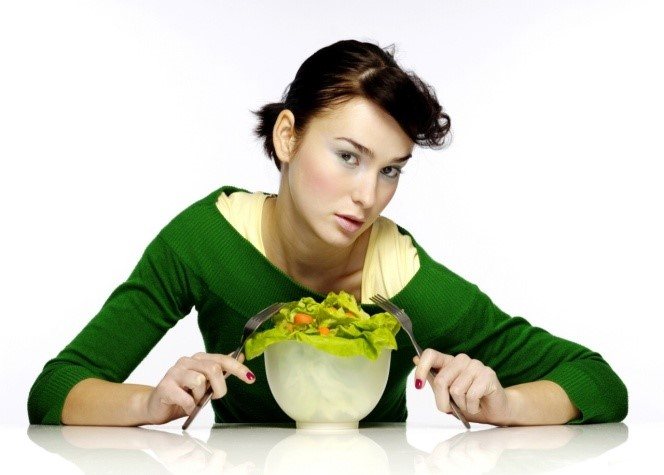
Note that the main point in the treatment of sigma diverticulosis is a diet that helps reduce muscle contractions and reduce pressure on weakened areas of the intestine. Some experts consider the statement about the harm of seeds and tiny particles on inflammation in diverticula unproven; however, it is better to avoid vegetables and fruits that contain seeds, especially if complaints appear after consumption. List of products that can aggravate the pathological process:
• kiwi; • tomatoes; • grape; • zucchini; • zucchini; • cucumber; • blackberries; • raspberries; • strawberry; • eggplants; • pepper.
Avoid vegetables that belong to the cruciferous family: Brussels sprouts and cauliflower. Seeds and nuts with diverticulosis can cause pain.
Avoid baked goods that contain peanuts, pistachios, cashews and almonds, as well as sunflower seeds, pumpkin seeds, cumin and sesame seeds.
Unprocessed dried fruits are difficult to digest in the gastrointestinal tract, so it is preferable to introduce either steamed prunes and dried apricots into the diet, or cook dried fruit compote.
Grains can be retained in the gastrointestinal tract, especially if there are “pockets” in the form of diverticula. Stuck grains undergo putrefactive fermentation processes and provoke an inflammatory process. In addition, the accompanying increased flatulence will contribute to pain and the appearance of new diverticula.
It is allowed to eat refined bread and cereals, preferably oatmeal. Pasta, white rice, semolina, and products made from premium flour are not recommended for diet with diverticulosis.
Nutritionists recommend including low-fat fermented milk products (kefir, fermented baked milk, matsoni, yogurt) in the diet; some patients digest whole milk well, but it is better to consult with your doctor about this.
In any case, products containing palm oil, margarine, cooking oil, and mayonnaise are not healthy.
Natural cheeses and cottage cheese can be eaten in small quantities if you have intestinal diverticulosis.
Other foods that are prohibited for diverticulosis and intestinal diverticulitis
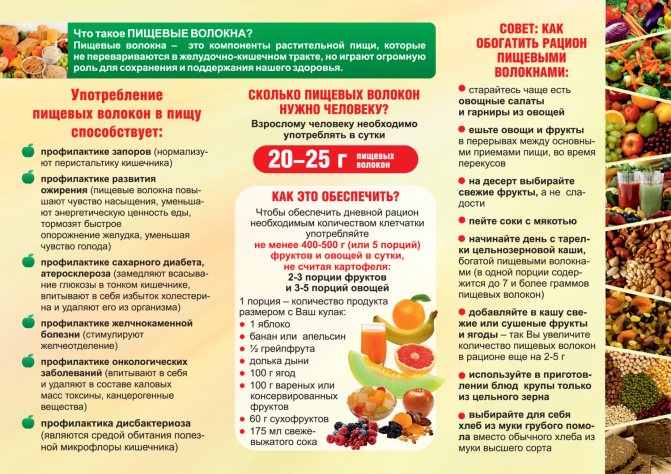
Red meat must be excluded or limited; the main diet for diverticulosis of the sigmoid colon is lean chicken, white fish, and broths.
Avoid carbonated drinks and sweets, as they can cause increased gas formation, which will worsen clinical symptoms.
Do not eat a lot of acidic foods; there is evidence that if you have problems with the gastrointestinal tract, the risk of allergic dermatitis increases. Also, do not overconsume oranges, lemons, and grapefruit.
Avoid refined high carbohydrate foods: Limit cakes, ice cream, pizza, puff pastries, pretzels, biscuits, doughnuts, canned juices, chocolate, muffins, white sugar, cream, pies, etc.
Read the labels on the packages: preservatives, sweeteners, dyes, etc. chemical advances will not add health.
Eliminate fatty and fried foods, fast food, French fries, and processed foods.
Instead, food prepared with the most gentle heat treatment is preferable: baked, boiled, steamed.
Alcohol and smoking always cause irritation of the colon and stomach, so it is better to get rid of bad habits.
Treatment at home for intestinal diverticulosis is possible if there are no serious complications: you can eat right, do special exercises for diverticulosis, and take prescribed medications at home.
Description and characteristics
Diverticulosis of the sigmoid colon is a disease of the descending colon with the formation of a large number of specific diverticula. These formations are growths on the walls of the intestine that resemble pouches. Appear as a result of strong stress when visiting the toilet.
Diverticula are usually located in the lower colon. Their sizes are small - like peas, but sometimes there are larger growths. They may occur due to increased flatulence or pressure of fecal masses on the internal walls of the intestine.
The disease is considered age-related. It has been called a “modern disease of society.” Most adult patients with intestinal diverticula live in large urban cities, where the prevailing trend of Western nutrition is the consumption of starchy and refined foods that are harmful to health.
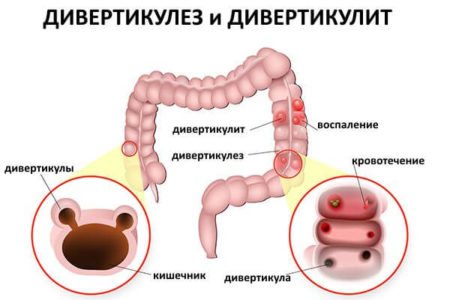
Diverticulosis and diverticulitis
Some recipes useful for diverticulosis
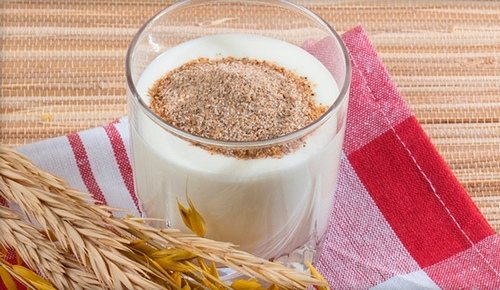
Add 1 tablespoon of bran to 200 ml of kefir or yogurt (any fermented milk product will do) and leave for 30 minutes to swell. Kefir with bran can be consumed instead of breakfast.
Gradually, the amount of bran is increased to 3 tablespoons, and at the same time, be sure to pay attention to your well-being: replacing constipation with frequent loose stools is not the best result. The target stool is soft, shaped, which helps prevent intestinal trauma, relieve inflammation and flatulence.
A decoction of mint, chamomile and plantain seeds has good anti-inflammatory properties.
To prepare, you need to take vegetable raw materials in equal proportions (1 teaspoon each), add 250 ml of boiling water, leave for 1.5 hours. Take 1/2 cup 3 times a day on an empty stomach, 30 minutes before meals, the course of treatment is 10 days.
1 tablespoon of olive, flaxseed or vegetable oil mixed in a glass of kefir will help get rid of constipation; take the resulting product shortly before bed. This recipe can be used for a long time.
A decoction of flax seeds also has a laxative effect.
Drugs for intestinal diverticulosis
Treatment with antibiotics and anti-inflammatory drugs is reasonable for diverticulitis. Conservative treatment for diverticulosis of the sigmoid colon, in addition to antibacterial agents, with associated inflammation, includes the following:
Read more Manual dilatation of the cervix
• drugs to improve intestinal motility; • antispasmodics; • laxatives; • vitamin complexes; • medications to increase hemoglobin.
In case of complications in the hospital, antibiotics are prescribed intravenously, which increases the effectiveness of treatment. Nutrition is provided parenterally, which makes it possible to “rest” the gastrointestinal tract.
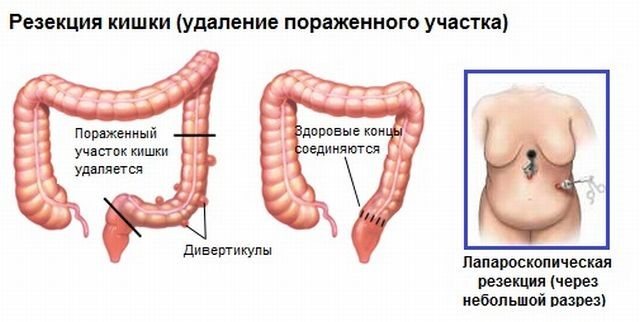
Surgery for diverticulosis of the sigmoid colon
In some cases, only surgical treatment can save lives: minimally invasive laparoscopic surgery - resection of the sigmoid colon, or open surgery. Surgery is resorted to in case of frequent relapses of the inflammatory process against the background of diverticulosis. The essence of the operation is the removal of the pathological area and stitching (anastomosis) of the ends of the intestine.
What drugs are used for diverticulosis and treatment regimens
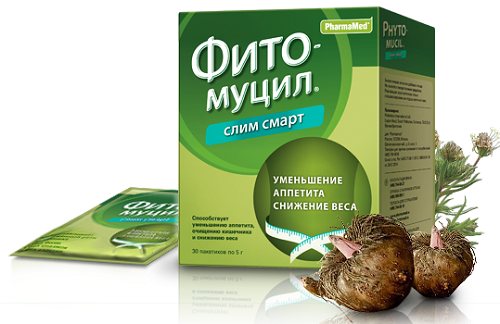
In addition to the diet, it is recommended to introduce insoluble plant fibers into the diet (wheat bran or Fitomucil norms (Mukofalk) 5 g/day).
According to indications (inflammatory process), it is possible to use Rifaximin 400 mg 2 times a day. every week of the month throughout the year. This increases the effectiveness of therapy by 2 times. Symptoms are also eliminated with Mesalazine at a dosage of 400 mg twice a day, 10 days of each month for a year.
If necessary, laxatives and medications are prescribed to normalize the composition of the intestinal microflora.
Recurrent diverticulitis, especially with an episode of perforation, involves surgery involving resection of the sigmoid colon due to the high risk of developing life-threatening conditions.
Note that suppositories for diverticulosis of the sigmoid colon do not exist; another thing is that there are suppositories that help fight constipation.
Important! In case of intestinal bleeding and suspected acute pathology (appendicitis, intestinal obstruction, peritonitis, etc.), suppositories cannot be used.
For intestinal diverticulosis, it is preferable to use osmotic drugs
, which do not enhance peristaltic movements, but have a laxative effect. These include:
• Lactulose; • Macrogol 4000; • Sorbitol; • Sodium sulfate.
Sorbitol for diverticulosis of the sigmoid colon promotes reparative processes in the mucous membrane, which prevents diverticulitis. Exceeding the recommended dose of osmotic laxatives may increase gas formation.
Laxatives with dietary fiber:
• Mucofalk; • Fiberlex; • Naturolax; • Fibercon.
Suppositories for diverticulosis should be used with caution, since long-term use, for example, of Bisacodyl-based suppositories, can be complicated by intestinal atony.
Suppositories with glycerin are considered a safe remedy with minimal side effects. Consult your doctor before use.
Diverticulosis of the sigmoid colon is a disorder when seals, called hernias, appear on the walls of the intestinal tract. These growths are called diverticula. They can remain in the intestines for many years, but do not show symptoms at all.
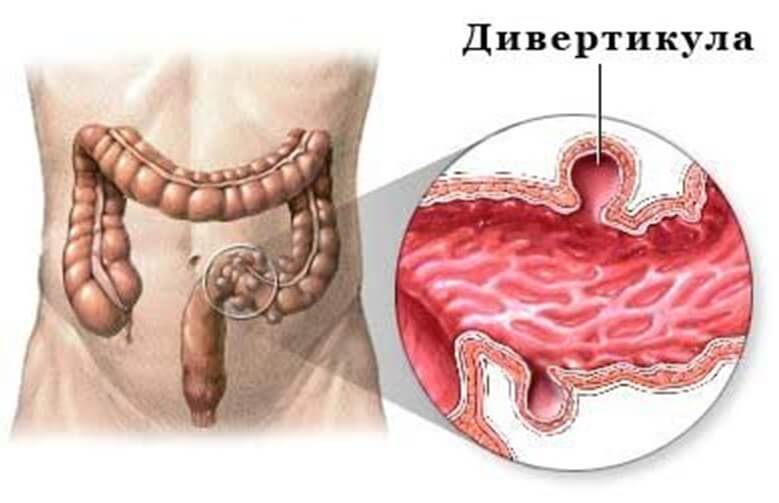
If an infection enters the intestinal tract, the diverticula become inflamed—diverticulitis. Formations come in different sizes. It all depends on the stages of formation of the disease. The pathological process is localized in the sigmoid colon - a section of the large intestine. The disease shakes sigma itself. During an exacerbation, the quality of life worsens. Let's analyze the issue of diverticulosis of the sigmoid colon, information about symptoms, treatment of the disease.
Principles and methods of therapy
Treatment of the disease takes into account the following factors:
- Forms of the disease.
- There is a risk of complications.
- Patient's age and nutrition.
- Having dangerous habits.
- Presence of concomitant diseases.
At the initial stage, the disease can be cured using conservative methods or folk recipes. And in severe cases, a radical measure will be needed - surgery.
If diverticulosis is not accompanied by unpleasant sensations and passes without symptoms, then the following measures are effective:
- Diet (table number 5).
- Physiotherapy.
- Use of antibiotics for diverticulitis.
- Taking drugs of various pharmacological categories that help improve intestinal motility, relieve inflammation, loosen stools, relieve pain, for example: Metronidazole.
Surgical treatment of the intestines
Surgical intervention will be needed only in case of complicated intestinal disease, especially when inflamed diverticula are life-threatening: peritonitis, severe hemorrhages, development of obstruction.
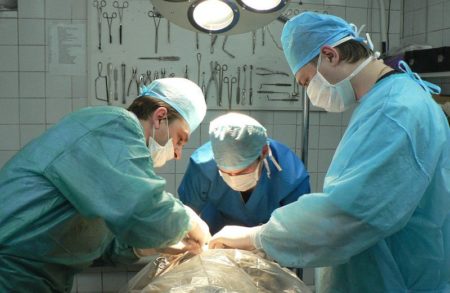
Operation
For patients with peritonitis, a number of resuscitation actions must be carried out before intervention: administer antibiotics by injection.
Important! In case of perforation of the large intestine, surgery is required. This complication is the most serious - about half of patients do not survive. If we consider purulent intestinal peritonitis due to rupture of a diverticulum abscess, the mortality rate will not be as high, but still significant.
A single operation will also be needed for patients with acute intestinal diverticulitis, which cannot be cured with conservative methods.
Application of alternative medicine
You cannot treat yourself with homemade folk recipes. They can be combined with medical treatment, following a proper diet, or during postoperative recovery. But before resorting to unconventional methods, you need to ask your doctor about it.
The most popular homeopathy remedies:
- Decoction of elm bark.
- Sea buckthorn infusion.
- Consuming pure flaxseed oil to reduce intestinal inflammation.
- Taking a whole clove of garlic on an empty stomach.
- Infusion of rosehip, dill herb, chamomile and valerian.
- Oatmeal jelly.
Causes of pathology
There are several circumstances under which people develop sigmoid diverticulosis. Let's look at the reasons in more detail:
- Age. When the muscles of the intestinal walls become weak, the process of destruction of the digestive organs begins.
- Weak connective tissues. This phenomenon can be observed at birth or after a failure in the formation of collagen fibers.
- Intestinal motility problems. With high pressure in the cavity of the intestinal tract, the fibers of the walls are weakened, and characteristic compactions appear.
- Muscle spasm. This activates contraction of intestinal vessels and disruption of blood circulation. As a result, the area near the vessels atrophies, and stretch marks appear. As a result, diverticula grow inside the intestinal tract.
- Hereditary character. The threat of getting sick increases a couple of times when elderly family members have difficulties with diverticula.
- Nutrition. Many studies have proven that in African countries, where people have been eating plant foods for a long time, they suffer from diverticulosis much less often than in the West, where meat foods predominate in the diet.
Drugs
Treatment with antibiotics and anti-inflammatory substances is justified for diverticulitis. Conservative therapy, in addition to antibacterial agents, for inflammation, looks like this:
- substances to improve intestinal motility;
- antispasmodics;
- laxatives;
- vitamin complexes;
- medications for hemoglobin growth.
In case of complications in the hospital, medications are administered intravenously, which increases the effectiveness of treatment. Nutrition is administered parenterally, which makes it possible to “rest” the gastrointestinal tract.
Early stage sigmoid diverticulosis can be treated with medication. The main medications on the list are:
| Diverticulum perforation | When perforation affects the peritoneal area, there is a high probability of peritonitis. |
| Alpha Normix |

Possible complications and prognosis
If complications develop, the patient's condition deteriorates sharply, significant weakness and sudden temperature rises are observed.
The most common complications:
- Hemorrhage in the intestines - appears unexpectedly due to damage to the blood vessels inside.
- Diverticulitis is a complex inflammation caused by pathogenic microorganisms that have developed in diverticula.
- Perforation of the diverticulum.
- Abscess inside a diverticulum. When the abscess penetrates the intestinal cavity, the patient's well-being may improve.
- Fistulas in the intestines or stomach.
- Intestinal obstruction - occurs due to a long adhesive process in the intestine.
Example of a diet for 7 days
Many gastroenterologists believe that patients with diverticulosis need to follow a separate nutrition method - consume proteins separately from carbohydrates. The body acquires a maximum of nutrients, and the process of digesting food is facilitated. Taking into account the advice of nutritionists and doctors, below is a 7-day diet for patients with diverticulosis of the large intestinal tract. The menu for each day is presented below:
- Monday and Tuesday. It is preferable to eat liquid food (soups with vegetables), fruits, herbal tea.
- Wednesday During the day - unload the body. You can drink kefir or eat only apples.
- Thursday . Fish day. You can use the broth with not very fatty river or sea fish.
- Friday . You can eat oatmeal or buckwheat porridge. For lunch you can eat boiled meat and pureed vegetables. It is preferable to eat an orange or banana for an afternoon snack. In the evening you can eat a few spoons of lean cottage cheese.
- Saturday . The day starts with a white omelet. A steamer is useful for cooking. It is preferable to season vegetable salad or porridge with vegetable oil. You can have yogurt for dinner.
- Sunday . You can make vegetable soup, bake fish, eat fruits, drink compote.
